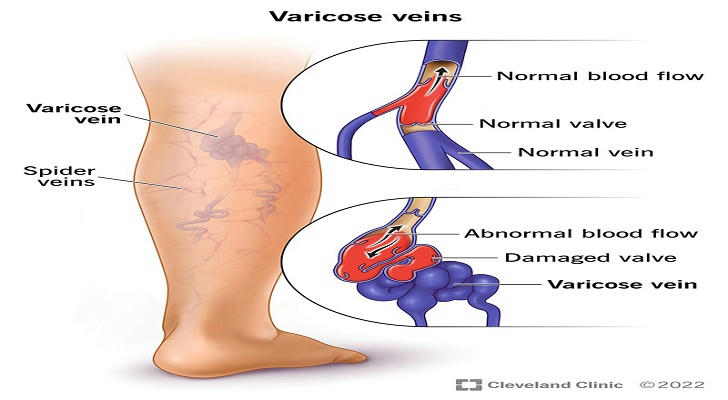Varicose Veins: A Common Yet Often Overlooked Vascular Issue
Varicose veins are among the most common vascular diseases, affecting approximately 28% of adults. These twisted, enlarged veins are not just a cosmetic concern—they can also lead to a range of health problems. This article provides a comprehensive overview of this frequently ignored condition.

What Are Varicose Veins?
Varicose veins occur when superficial veins become abnormally dilated and twisted, most commonly in the lower limbs. When the valves inside the veins malfunction, blood cannot efficiently return to the heart, leading to pooling and vein enlargement.
Key Characteristics:
- Visible blue or purple twisted veins beneath the skin
- Bulging, rope-like veins
- Most often appear on the calves and inner thighs
Epidemiology in the U.S.
The prevalence of varicose veins in the U.S. is striking:
- Approximately 30-40 million Americans suffer from varicose veins
- Affects up to 50% of people over 50 years old
- Women are 2-3 times more likely to develop them than men
- Annual healthcare costs exceed $1.5 billion
Major Risk Factors
Understanding risk factors can aid in prevention and early detection:
- Genetics: Family history increases risk by 40-50%
- Age: Risk rises significantly after 50
- Gender: Hormonal changes and pregnancy make women more susceptible
- Occupation: Jobs requiring prolonged standing (teachers, nurses, retail workers, etc.)
- Obesity: BMI >30 increases risk by 30%
- Sedentary lifestyle
- Pregnancy: Hormonal shifts and uterine pressure elevate risk
- History of deep vein thrombosis (DVT)
Symptoms and Complications
Varicose veins are more than just a cosmetic issue and may cause:
Common Symptoms:
- Heaviness and fatigue in the legs
- Pain, cramping, or burning sensations
- Itching, especially around the ankles
- Nighttime leg discomfort disrupting sleep
- Worsening symptoms after prolonged standing or sitting
Potential Complications:
- Venous eczema: Thinning, dry, itchy skin
- Hyperpigmentation: Brownish skin discoloration around the ankles
- Venous ulcers: Non-healing leg wounds (occurs in ~4% of patients)
- Superficial thrombophlebitis: Painful blood clots in veins
- Bleeding risk: Ruptured varicose veins may cause bleeding
Diagnostic Methods
U.S. healthcare providers typically follow this diagnostic process:
- Physical examination: Visual inspection and palpation of veins
- Duplex ultrasound (Gold Standard):
- Evaluates vein valve function
- Detects blood clots
- Assesses blood flow direction
- Venography (used in rare, complex cases)
Main Treatment Options in the U.S.
Treatment depends on severity:
Conservative Management
- Compression therapy: Medical-grade compression stockings (20-30 mmHg or 30-40 mmHg pressure)
- Lifestyle modifications:
- Regular exercise (walking, swimming)
- Weight management
- Avoiding prolonged standing/sitting
- Leg elevation (above heart level)
Minimally Invasive Treatments (Outpatient Procedures)
- Sclerotherapy: Injection of a solution to close small veins
- Endovenous Laser Therapy (EVLT): Laser heat seals the vein
- Radiofrequency Ablation (RFA): Uses high-frequency current to close veins
- Venous glue closure: Medical adhesive seals the vein
Surgical Options
- Vein stripping: Traditional surgery for large varicose veins
- Ambulatory phlebectomy: Minimally invasive removal through tiny incisions
Prevention Strategies
The American Venous Forum recommends:
- Regular exercise (especially calf-strengthening activities)
- Weight control
- Avoid prolonged standing/sitting (move every 30 minutes)
- Wear compression stockings (high-risk individuals)
- Elevate legs daily (15-20 minutes)
- Balanced diet (high-fiber, low-sodium)
- Avoid excessive heat (hot baths, saunas may worsen symptoms)
When to Seek Medical Help
U.S. doctors advise consulting a specialist if you experience:
- Painful, warm, or reddened veins
- Skin discoloration around veins
- Leg ulcers or persistent itching
- Vein bleeding
- Symptoms affecting daily life
Insurance Coverage in the U.S.
Most insurance plans (including Medicare) cover treatment if:
- Symptoms impair quality of life
- Conservative treatments fail
- There’s risk of complications
- Diagnosis is confirmed via ultrasound
Purely cosmetic treatments are generally not covered.
Latest Research Advancements
Cutting-edge U.S. research includes:
- Next-gen vein glues: Longer-lasting, safer closure
- Mechanochemical ablation: Combines mechanical and chemical methods
- Gene therapy: Targets vein valve repair
- Stem cell therapy: Regenerates damaged vein tissue
Conclusion
Varicose veins are a widespread vascular condition that, while not life-threatening, significantly impacts quality of life. Early intervention can effectively manage symptoms and prevent complications. The U.S. offers advanced diagnostics and multiple treatment options, most of which are minimally invasive outpatient procedures with quick recovery times. If you have symptoms or risk factors, consult a vascular specialist.
Remember: Venous health is a vital part of overall well-being. Don’t dismiss varicose veins as "just a cosmetic issue"—proactive prevention and treatment can keep them under control.